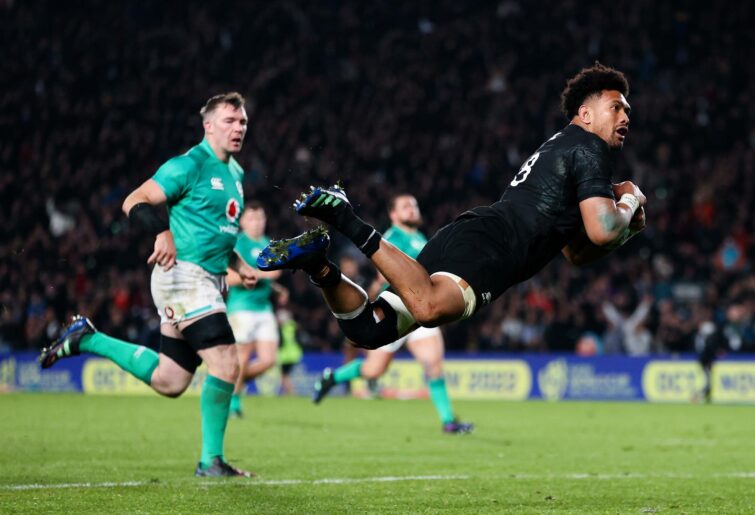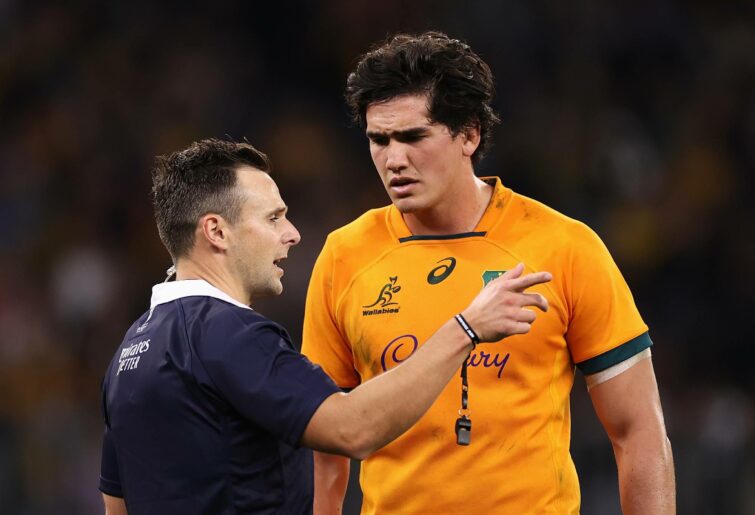First things first; leading last week’s column with the four southern hemisphere, Rugby Championships nations all winning, demands the same attention be given this week to all four home nations squaring their series at one-all.
That’s some turnaround. Think the last two weekends have been intense? Try next weekend when all four north versus south series are on the line.
One way to measure the intensity is to glance at the casualty wards. In two matches, Australia has been forced into using five different fullbacks. That’s plain crazy.
Izaia Perese’s and Cadeyrn Neville’s knees haven’t gone the distance. Then there’s the concussions. Or, dare I say it, the brain injuries. More on that soon.
Another measure of intensity is all of the palaver and carry on that attaches itself to Test matches, where the stakes are amplified, and normally sane people lose perspective and very nearly their minds.
That reached a nadir in last year’s Lions tour of South Africa, but it seems that mass hysteria is never far away, bubbling away under the surface.
We‘re talking here (aren’t we always?) about referees throwing yellow and red cards about like confetti, and the pain rugby subjects itself to via its insistence upon the upholding of laws that many coaches and players, and vocal commentators and fans would prefer to see abolished.
On this topic at least, referees are spared much of the vitriol, forced to referee according to laws and frameworks provided to them, manufactured by others.
In Brisbane, first Perese, then England’s Marcus Smith, received yellow cards for deliberate knocking the ball away to prevent an opponent catching it. “What else are they supposed to do?” was the common catch-cry.
Well, in Perese’s case, he had options. Attempt to catch the ball with two hands, for a start. Or use one hand if he must, but actually catch it. Or drift a bit wider, wait for his marker to catch the ball, and drive him into the ground with a tackle.
I recall Jonah Lomu, playing for the Hurricanes against the Waratahs at the Sydney Football Stadium in 2000, being red-carded (second yellow) for very similar to what Perese did. That’s 22 years ago; none of this stuff is new.
Perhaps if players can’t accept what the law is and modify their behaviour after all of this time, then they don’t deserve the sympathy being afforded them? On the other hand, if players are still railing against a law after so long, perhaps there really is something wrong with the law?
In any case, none of this means rugby is broken.
Just that one of three things needs to happen; World Rugby reaffirms its position about wanting to reward attacking rugby and prevent the blocking of passes and further educates the rugby public and commentariat about why the law exists; the law stays but referees are given more wriggle room to distinguish between deliberate slap downs and genuine intercept attempts; or the whole thing is buried, and rugby league’s ‘anything goes’ approach is adopted.
It’s hard to recall a crazier half-hour of Test rugby as occurred under the roof in Dunedin. Referee Jaco Peyper issued four cards, various All Blacks wore holes in the turf coming on and off the pitch, and the sideline officials and All Blacks’ management couldn’t keep up.
The upshot was that Ardie Savea inadvertently ended up holding the short straw, with hard questions being asked of both the All Blacks and the match officials afterwards, about how things got to Savea and not Dalton Papalii being excommunicated.
Once they figure it all out, I’m sure we’ll all be kept informed.

(Photo by Phil Walter/Getty Images)
To make matters worse, the All Blacks were required to pack a defensive scrum with both Quinn Tupaea and Beauden Barrett – following in the footsteps of Kurtley Beale – lending a shoulder.
But not only did Ireland conspire to mess up a 7 versus 5 numerical advantage in the backline, the match officials missed the law that required the All Blacks to shed another player – required when a match is forced into uncontested scrums via the issuing of a red card.
Unsurprisingly, a lot of Ireland’s terrific win was overshadowed by frustrated commentary around a match supposedly once again being determined by which way the cards fell.
Yet none of Leicester Fa’ainganuku, Ofa Tu’ungafasi or James Ryan could be considered unlucky; in fact a compelling case existed for Tu’ungafasi’s early tackle on Robbie Henshaw to warrant a penalty try.
Only Ta’avao could count himself unlucky, although not as unlucky as Garry Ringrose, whose head he collided with on a switchback play. No matter that this had the strong whiff of an accidental collision, these head clashes have been paid as red cards all season.
Once Ta’avao was brought back to his senses, there was ever only going to be one outcome.
Once again, the sticking point becomes the matter of intent. The send-off or red card served rugby well over its amateur and early professional history, reserved as it was for acts of egregious foul play.
But as the tolerance has been lowered, the red card has become a catch-all for many more things, not all of them of foul intent. If the punishment once fitted the crime, nowadays, in many cases, it patently does not.
With World Rugby recently dismissing Super Rugby Pacific’s 20-minute red card, in the name of the greater good when it comes to player safety, this turkey shoot looks likely to continue for some time yet.
No matter that an obvious solution exists; reserve red cards (no replacement) for clear acts of foul play, lump everything else into the yellow card bracket so that match officials aren’t placed in the difficult position of being forced to guess at points of contact, degrees of force, level of intent and so on, and have a citing commissioner determine afterwards – away from the heat of the game, using superior technology – which players face the judiciary.

(Photo by Cameron Spencer/Getty Images)
Deterrence would be maintained by suspension periods for players found guilty of serious acts of foul play being made significantly stiffer than what currently exists.
All of these are important discussion points. Good rugby people insist they are being turned off the game, and it is incumbent on rugby’s law makers and custodians to listen carefully, no matter how well intentioned they may be when it comes to player safety.
But they are the wrong discussion points.
Across the two trans-Tasman series, Sam Underhill, Tom Curry, Maro Itoje, Alan Ala’alatoa, Jordan Petaia, Angus Ta’avoa, Garry Ringrose and Sam Whitelock have all suffered serious head knocks. Peter O’Mahoney is currently undergoing assessment.
Johnny Sexton also failed an HIA in Auckland’s first Test, although was subsequently cleared to play in Dunedin in an all-too-cute side-stepping of World Rugby’s freshly minted mandatory 12-day stand down.
So much for ‘when in doubt, sit them out’.
The Roar experts Brett McKay, Harry Jones and Jim Tucker discuss England’s win in the second Test in an instant reaction podcast
Other players in action over the last fortnight have recent, troublesome histories, including suffering serious concussions over the last 12 months. This list includes, but isn’t limited to, Beauden Barrett, Sam Cane, James Ryan, Owen Farrell, Noah Lolesio, James Slipper and Taniela Tupou.
In the opening tour match against NZ Maori, Ireland prop Jeremy Loughman was heavily concussed, yet was allowed to return to the field after an assessment. NZ Rugby later acknowledged fault with their handling, but none of that changes the potential outcome for Loughman, nor does it provide any confidence that rugby’s authorities truly have the issue in hand.
Unhelpfully, the concussion debate has been conflated into the debate and dispute about cards. The two are related, for sure, but it is far more than this.
It is also infested with influential TV commentators ignorant of the protocols and guidelines, fostering wider confusion through ill-advised commentary.
Many of the players listed above were not victims of foul play. Head injury occurs in all manner of guises, and to World Rugby’s credit, it has pursued an evidence-based approach to determining how and why so many concussions occur.

(Photo by Mark Kolbe/Getty Images)
But “how” and “why” tell only part of the story. The “what” has not kept pace.
What law and structural modifications will continue to be made to make the game safer to play, and ease the concerns of parents considering allowing their sons and daughters to play?
What will be done to make rugby less gladiatorial, without emasculating the game? Is this even possible? (World Rugby is said to be seriously considering reducing the size of the bench in professional rugby, in an attempt to heighten fatigue and ‘de-power’ the game).
What coaching modifications around the tackle can and will be made? Will coaches be prepared to concede the offload in return for minimising the number of upright and two-man tackles, which increase the chance of forceful head contact?
New Zealanders may beg to differ but there was much to take from the weekend. England’s assertive reply, led by a dominant Billy Vunipola and Courtney Lawes.
Australia’s stirring comeback, once again under adversity, led by Matt Philip’s sheer competitiveness at lineout, and the failure of some of their bench players to seize the initiative, when the match was there for the taking.
What about Ireland’s superb beginning? Accuracy personified. Blistering without being manic. Sexton at his mercurial best. And, despite all of the gloom across the Tasman, what about the fighting spirit the All Blacks showed to only be down 7-10 at half-time, when the deficit could easily have been 20 points?
Somehow however, too many of the questions and discussion points arising default to the same recurring themes. Can Ian Foster coach? Is Eddie Jones trolling everybody once again? Is rugby being ruined by a card lottery?
Because people care, it’s understandable that these matters draw an emotional response and suck all of the oxygen out of the post-match. They are valid and important questions.
But they are also the wrong questions. Cast your eye again over the list of players who have suffered concussions – brain injury – over the last fortnight. And those over the last year. And think of all of the players who have suffered similar injuries away from the spotlight, in lower professional ranks, club and junior rugby.
I don’t care if Marcus Smith deliberately knocked down a pass or was genuinely trying for an intercept. Let the ref decide and everyone move on.
I do care about the long-term health outcomes for all of those players listed above. They may all be fine. Steve Thompson, Alix Popham, Jamie Cudmore, Carl Hayman, Geoff Old and countless others are here to tell you they may not be.
If we can look past Ireland’s wobbly last two weeks in New Zealand, and agree that concussed players are much better managed these days, there remains the unshakeable conclusion that too many players are being hit in the head.
That’s what needs fixing.































































































